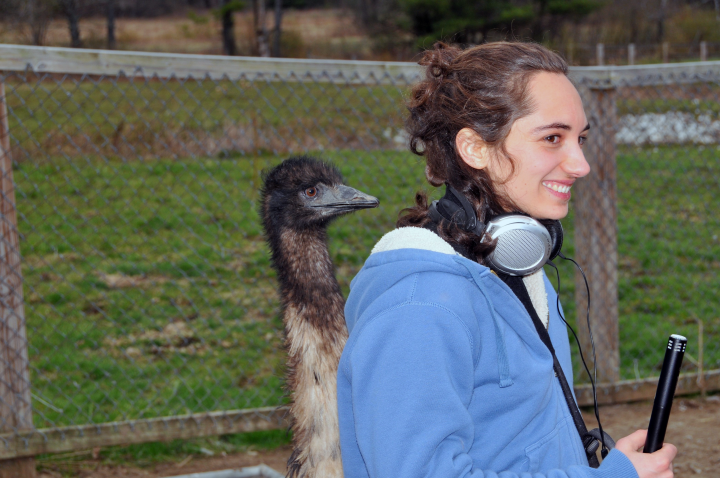Dr. Laurel Symes As the Assistant Director of the K. Lisa Yang Center for Conservation Bioacoustics, my goal is to maximize the accessibility and effectiveness of acoustic tools for research and conservation. I work with the Yang Center capacity building team to develop introductory and advanced training materials and courses, and to provide intensive professional mentorship and training. Scientifically, I coordinate the tropical biology research program, focusing in Central and South America and working with teams from Central Africa and Southeast Asia to develop research approaches and tools that span tropical terrestrial habitats.
In my research, I work at the intersection of ecology, evolution, conservation, and technical development. I conduct research across a variety of taxa, including insects, frogs, bats, and birds in both temperate and tropical systems. I have a particular research interest in the evolution of signaling rates, how often animals repeat signals over days, months, or years, a historically difficult data type to access. Signal rate is central to using acoustics to estimate population density, and is shaped by many factors, including morphology, physiology, seasonality, energetics, and interactions within and between species.
Year Hired : 2018
Contact Information symes@cornell.edu
Degree(s) :
Recent Publications
2394371
Symes
items
1
50
year
des
year
Symes
6498
https://www.birds.cornell.edu/ccb/wp-content/plugins/zotpress/
%7B%22status%22%3A%22success%22%2C%22updateneeded%22%3Afalse%2C%22instance%22%3A%22zotpress-362cb616faefe828bc59ab79ed3adb96%22%2C%22meta%22%3A%7B%22request_last%22%3A0%2C%22request_next%22%3A0%2C%22used_cache%22%3Atrue%7D%2C%22data%22%3A%5B%7B%22key%22%3A%226ZKTRX9V%22%2C%22library%22%3A%7B%22id%22%3A2394371%7D%2C%22meta%22%3A%7B%22creatorSummary%22%3A%22Soanes%20et%20al.%22%2C%22parsedDate%22%3A%222023-08-22%22%2C%22numChildren%22%3A1%7D%2C%22bib%22%3A%22%3Cdiv%20class%3D%5C%22csl-bib-body%5C%22%20style%3D%5C%22line-height%3A%201.35%3B%20%5C%22%3E%5Cn%20%20%3Cdiv%20class%3D%5C%22csl-entry%5C%22%3ESoanes%2C%20L.M.%20%3Ci%3Eet%20al.%3C%5C%2Fi%3E%20%282023%29%20%26%23x2018%3BPassive%20acoustic%20monitoring%20of%20birds%20in%20the%20Lesser%20Antilles%26%23x2014%3Ba%20useful%20tool%20for%20monitoring%20remote%20sites%3F%26%23x2019%3B%2C%20%3Ci%3EJournal%20of%20Caribbean%20Ornithology%3C%5C%2Fi%3E%2C%2036%2C%20pp.%2062%26%23x2013%3B74.%20Available%20at%3A%20%3Ca%20href%3D%27https%3A%5C%2F%5C%2Fdoi.org%5C%2F10.55431%5C%2Fjco.2023.36.62-74%27%3Ehttps%3A%5C%2F%5C%2Fdoi.org%5C%2F10.55431%5C%2Fjco.2023.36.62-74%3C%5C%2Fa%3E.%3C%5C%2Fdiv%3E%5Cn%3C%5C%2Fdiv%3E%22%2C%22data%22%3A%7B%22itemType%22%3A%22journalArticle%22%2C%22title%22%3A%22Passive%20acoustic%20monitoring%20of%20birds%20in%20the%20Lesser%20Antilles%5Cu2014a%20useful%20tool%20for%20monitoring%20remote%20sites%3F%22%2C%22creators%22%3A%5B%7B%22creatorType%22%3A%22author%22%2C%22firstName%22%3A%22Louise%20M.%22%2C%22lastName%22%3A%22Soanes%22%7D%2C%7B%22creatorType%22%3A%22author%22%2C%22firstName%22%3A%22Devon%22%2C%22lastName%22%3A%22Carter%22%7D%2C%7B%22creatorType%22%3A%22author%22%2C%22firstName%22%3A%22Laurel%20Braden%22%2C%22lastName%22%3A%22Symes%22%7D%2C%7B%22creatorType%22%3A%22author%22%2C%22firstName%22%3A%22Jennifer%20C.%22%2C%22lastName%22%3A%22Daltry%22%7D%2C%7B%22creatorType%22%3A%22author%22%2C%22firstName%22%3A%22Holger%22%2C%22lastName%22%3A%22Klinck%22%7D%2C%7B%22creatorType%22%3A%22author%22%2C%22firstName%22%3A%22Clarissa%22%2C%22lastName%22%3A%22Lloyd%22%7D%2C%7B%22creatorType%22%3A%22author%22%2C%22firstName%22%3A%22Farah%22%2C%22lastName%22%3A%22Mukhida%22%7D%5D%2C%22abstractNote%22%3A%22Abstract%5Cu00a0%20The%20monitoring%20of%20bird%20species%20across%20their%20geographic%20ranges%20is%20essential%20in%20order%20to%20assess%20population%20status%20and%20trends%20and%20to%20inform%20conservation%20action.%20However%2C%20undertaking%20monitoring%2C%20particularly%20in%20the%20long-term%2C%20is%20often%20resource-intensive%20and%20costly.%20In%20recent%20years%2C%20the%20use%20of%20passive%20acoustic%20monitoring%20%28PAM%29%20has%20emerged%20as%20a%20useful%20monitoring%20tool.%20Birds%20are%20especially%20appropriate%20for%20bioacoustic%20monitoring%20because%20they%20regularly%20produce%20species-specific%20vocalizations.%20Here%20we%20report%20on%20pilot%20deployments%20of%20autonomous%20recording%20units%20%28ARUs%29%20on%20the%20island%20of%20Anguilla.%20ARUs%20were%20deployed%20for%20up%20to%207%20days%20and%20the%20recorded%20data%20was%20subject%20to%20analysis%20by%20BirdNET%2C%20an%20automated%20bird%20recognition%20software.%20BirdNET%20identified%2043%2C655%20vocalizations%20from%2075%20species%2C%20of%20which%2048%20species%20were%20confirmed%20manually%20%2827%20were%20identified%20as%20false%20positives%29.%20The%20cumulative%20number%20of%20species%20recorded%20plateaued%20after%20approximately%203%20days%20of%20recording%20and%20the%20highest%20level%20of%20activity%20%28peak%20number%20of%20vocalizations%29%20were%20found%20between%200400%5Cu20130900%20and%201800%5Cu20131900.%20When%20compared%20to%20point%20counts%2C%20PAM%20identified%20more%20species%20at%20each%20site%20but%20did%20not%20record%20any%20species%20that%20had%20not%20been%20previously%20recorded%20in%20Anguilla.%20We%20conclude%20that%20PAM%20can%20serve%20as%20a%20useful%20tool%20for%20monitoring%20the%20presence%20of%20birds%2C%20particularly%20at%20remote%20sites%20where%20access%20may%20be%20difficult%2C%20and%20could%20prove%20to%20be%20valuable%20in%20the%20establishment%20of%20long-term%20monitoring%20programs.%5Cn%5Cn%5CnKeywords%5Cu00a0%20ARU%2C%20bioacoustics%2C%20BirdNET%2C%20Caribbean%2C%20Lesser%20Antilles%2C%20migratory%20birds%2C%20PAM%5Cn%5Cn%5CnResumen%5Cu00a0%20Monitoreo%20ac%5Cu00fastico%20pasivo%20de%20aves%20en%20las%20Antillas%20Menores%3A%20%5Cu00bfuna%20herramienta%20%5Cu00fatil%20para%20el%20monitoreo%20de%20sitios%20remotos%3F%20%5Cu2022%20El%20monitoreo%20de%20las%20especies%20de%20aves%20en%20toda%20su%20%5Cu00e1rea%20de%20distribuci%5Cu00f3n%20geogr%5Cu00e1fica%20es%20esencial%20para%20evaluar%20el%20estado%20y%20las%20tendencias%20poblacionales%2C%20y%20para%20fundamentar%20las%20acciones%20de%20conservaci%5Cu00f3n.%20Sin%20embargo%2C%20llevar%20a%20cabo%20el%20monitoreo%2C%20particularmente%20a%20largo%20plazo%2C%20a%20menudo%20requiere%20muchos%20recursos%20y%20es%20costoso.%20En%20los%20%5Cu00faltimos%20a%5Cu00f1os%2C%20el%20uso%20del%20monitoreo%20ac%5Cu00fastico%20pasivo%20%28PAM%29%20se%20ha%20revelado%20como%20una%20herramienta%20%5Cu00fatil%20para%20el%20monitoreo.%20Las%20aves%20son%20especialmente%20apropiadas%20para%20el%20monitoreo%20bioac%5Cu00fastico%2C%20porque%20producen%20regularmente%20vocalizaciones%20especie-espec%5Cu00edficas.%20Aqu%5Cu00ed%20presentamos%20un%20informe%20sobre%20la%20implementaci%5Cu00f3n%20piloto%20de%20unidades%20de%20grabaci%5Cu00f3n%20aut%5Cu00f3nomas%20%28ARU%29%20en%20la%20isla%20de%20Anguila.%20Las%20ARU%20se%20utilizaron%20durante%20un%20m%5Cu00e1ximo%20de%207%20d%5Cu00edas%20y%20los%20datos%20registrados%20se%20analizaron%20con%20BirdNET%2C%20un%20software%20de%20reconocimiento%20autom%5Cu00e1tico%20de%20aves.%20BirdNET%20identific%5Cu00f3%2043.655%20vocalizaciones%20de%2075%20especies%2C%20de%20las%20cuales%2048%20especies%20se%20confirmaron%20manualmente%20%2827%20se%20identificaron%20como%20falsos%20positivos%29.%20El%20n%5Cu00famero%20acumulado%20de%20especies%20registradas%20se%20estabiliz%5Cu00f3%20despu%5Cu00e9s%20de%20aproximadamente%203%20d%5Cu00edas%20de%20grabaci%5Cu00f3n%2C%20y%20el%20nivel%20m%5Cu00e1s%20alto%20de%20actividad%20%28n%5Cu00famero%20m%5Cu00e1ximo%20de%20vocalizaciones%29%20se%20encontr%5Cu00f3%20entre%20las%200400%5Cu20130900%20y%20las%201800%5Cu20131900.%20En%20comparaci%5Cu00f3n%20con%20los%20puntos%20de%20conteo%2C%20el%20PAM%20permiti%5Cu00f3%20identificar%20m%5Cu00e1s%20especies%20en%20cada%20sitio%2C%20pero%20no%20se%20encontr%5Cu00f3%20ninguna%20que%20no%20se%20hubiera%20registrado%20previamente%20en%20Anguila.%20Concluimos%20que%20el%20PAM%20puede%20servir%20como%20una%20herramienta%20%5Cu00fatil%20para%20monitorear%20la%20presencia%20de%20aves%2C%20particularmente%20en%20sitios%20remotos%20donde%20el%20acceso%20puede%20ser%20dif%5Cu00edcil%2C%20y%20que%20podr%5Cu00eda%20resultar%20valioso%20en%20el%20establecimiento%20de%20programas%20de%20monitoreo%20a%20largo%20plazo.%5Cn%5Cn%5CnPalabras%20clave%5Cu00a0%20Antillas%20Menores%2C%20ARU%2C%20aves%20migratorias%2C%20bioac%5Cu00fastica%2C%20BirdNET%2C%20Caribe%2C%20PAM%20%5Cu00a0%5Cn%5Cn%5CnR%5Cu00e9sum%5Cu00e9%5Cu00a0%20Suivi%20acoustique%20passif%20des%20oiseaux%20dans%20les%20Petites%20Antilles%20%5Cu2013%20Un%20outil%20utile%20pour%20le%20suivi%20de%20sites%20%5Cu00e9loign%5Cu00e9s%20%3F%20%5Cu2022%20Le%20suivi%20des%20esp%5Cu00e8ces%20d%5Cu2019oiseaux%20sur%20l%5Cu2019ensemble%20de%20leur%20aire%20de%20r%5Cu00e9partition%20g%5Cu00e9ographique%20est%20essentiel%20pour%20%5Cu00e9valuer%20l%5Cu2019%5Cu00e9tat%20et%20les%20tendances%20des%20populations%20et%20pour%20orienter%20les%20mesures%20de%20conservation.%20Toutefois%2C%20la%20mise%20en%20%5Cu0153uvre%20d%5Cu2019un%20suivi%2C%20en%20particulier%20%5Cu00e0%20long%20terme%2C%20est%20co%5Cu00fbteuse%20et%20n%5Cu00e9cessite%20souvent%20des%20ressources%20importantes.%20Ces%20derni%5Cu00e8res%20ann%5Cu00e9es%2C%20le%20suivi%20acoustique%20passif%20%28PAM%20%5Cu2013%20passive%20acoustic%20monitoring%29%20est%20apparu%20comme%20un%20outil%20de%20suivi%20utile.%20Les%20oiseaux%20se%20pr%5Cu00eatent%20particuli%5Cu00e8rement%20bien%20au%20suivi%20bioacoustique%2C%20car%20ils%20%5Cu00e9mettent%20r%5Cu00e9guli%5Cu00e8rement%20des%20vocalisations%20propres%20%5Cu00e0%20leur%20esp%5Cu00e8ce.%20Nous%20pr%5Cu00e9sentons%20ici%20le%20d%5Cu00e9ploiement%20pilote%20d%5Cu2019unit%5Cu00e9s%20d%5Cu2019enregistrement%20autonomes%20%28ARU%20%5Cu2013%20autonomous%20recording%20units%29%20sur%20l%5Cu2019%5Cu00eele%20d%5Cu2019Anguilla.%20Les%20unit%5Cu00e9s%20ont%20%5Cu00e9t%5Cu00e9%20d%5Cu00e9ploy%5Cu00e9es%20pendant%207%20jours%20et%20les%20donn%5Cu00e9es%20enregistr%5Cu00e9es%20ont%20%5Cu00e9t%5Cu00e9%20analys%5Cu00e9es%20par%20BirdNET%2C%20un%20logiciel%20de%20reconnaissance%20automatique%20des%20oiseaux.%20BirdNET%20a%20identifi%5Cu00e9%2043%20655%20vocalisations%20de%2075%20esp%5Cu00e8ces%2C%20dont%2048%20esp%5Cu00e8ces%20confirm%5Cu00e9es%20manuellement%20%2827%20ont%20%5Cu00e9t%5Cu00e9%20identifi%5Cu00e9es%20comme%20faux%20positifs%29.%20Le%20nombre%20cumul%5Cu00e9%20d%5Cu2019esp%5Cu00e8ces%20enregistr%5Cu00e9es%20a%20atteint%20un%20plateau%20apr%5Cu00e8s%20environ%203%20jours%20d%5Cu2019enregistrement%20et%20le%20niveau%20d%5Cu2019activit%5Cu00e9%20le%20plus%20%5Cu00e9lev%5Cu00e9%20%28nombre%20maximal%20de%20vocalisations%29%20a%20%5Cu00e9t%5Cu00e9%20observ%5Cu00e9%20de%2004h00%20%5Cu00e0%2009h00%20et%20de%2018h00%20%5Cu00e0%2019h00.%20En%20comparaison%20avec%20les%20points%20d%5Cu2019%5Cu00e9coute%2C%20le%20suivi%20acoustique%20passif%20a%20identifi%5Cu00e9%20plus%20d%5Cu2019esp%5Cu00e8ces%20sur%20chaque%20site%2C%20mais%20n%5Cu2019a%20pas%20enregistr%5Cu00e9%20d%5Cu2019esp%5Cu00e8ces%20qui%20n%5Cu2019avaient%20pas%20%5Cu00e9t%5Cu00e9%20contact%5Cu00e9es%20auparavant%20%5Cu00e0%20Anguilla.%20Nous%20concluons%20que%20le%20suivi%20acoustique%20passif%20peut%20%5Cu00eatre%20un%20outil%20utile%20pour%20suivre%20la%20pr%5Cu00e9sence%20d%5Cu2019oiseaux%2C%20en%20particulier%20sur%20les%20sites%20%5Cu00e9loign%5Cu00e9s%20o%5Cu00f9%20l%5Cu2019acc%5Cu00e8s%20peut%20%5Cu00eatre%20difficile%2C%20et%20qu%5Cu2019il%20pourrait%20s%5Cu2019av%5Cu00e9rer%20pr%5Cu00e9cieux%20pour%20la%20mise%20en%20place%20de%20programmes%20de%20suivi%20%5Cu00e0%20long%20terme.%5Cn%5CnMots%20cl%5Cu00e9s%20%5Cu00a0ARU%2C%20bioacoustique%2C%20BirdNET%2C%20Cara%5Cu00efbes%2C%20oiseaux%20migrateurs%2C%20PAM%2C%20Petites%20Antilles%2C%20suivi%20acoustique%20passif%2C%20unit%5Cu00e9s%20d%5Cu2019enregistrement%20autonomes%22%2C%22date%22%3A%222023%5C%2F08%5C%2F22%22%2C%22language%22%3A%22en%22%2C%22DOI%22%3A%2210.55431%5C%2Fjco.2023.36.62-74%22%2C%22ISSN%22%3A%221544-4953%22%2C%22url%22%3A%22https%3A%5C%2F%5C%2Fjco.birdscaribbean.org%22%2C%22collections%22%3A%5B%22IMWW9QTW%22%5D%2C%22dateModified%22%3A%222023-08-30T15%3A06%3A24Z%22%7D%7D%2C%7B%22key%22%3A%22IFT7KDVE%22%2C%22library%22%3A%7B%22id%22%3A2394371%7D%2C%22meta%22%3A%7B%22creatorSummary%22%3A%22Rameau%20et%20al.%22%2C%22parsedDate%22%3A%222023%22%2C%22numChildren%22%3A2%7D%2C%22bib%22%3A%22%3Cdiv%20class%3D%5C%22csl-bib-body%5C%22%20style%3D%5C%22line-height%3A%201.35%3B%20%5C%22%3E%5Cn%20%20%3Cdiv%20class%3D%5C%22csl-entry%5C%22%3ERameau%2C%20A.%20%3Ci%3Eet%20al.%3C%5C%2Fi%3E%20%282023%29%20%26%23x2018%3BChanges%20in%20Cough%20Airflow%20and%20Acoustics%20After%20Injection%20Laryngoplasty%26%23x2019%3B%2C%20%3Ci%3EThe%20Laryngoscope%3C%5C%2Fi%3E%2C%20133%28S3%29%2C%20pp.%20S1%26%23x2013%3BS14.%20Available%20at%3A%20%3Ca%20href%3D%27https%3A%5C%2F%5C%2Fdoi.org%5C%2F10.1002%5C%2Flary.30255%27%3Ehttps%3A%5C%2F%5C%2Fdoi.org%5C%2F10.1002%5C%2Flary.30255%3C%5C%2Fa%3E.%3C%5C%2Fdiv%3E%5Cn%3C%5C%2Fdiv%3E%22%2C%22data%22%3A%7B%22itemType%22%3A%22journalArticle%22%2C%22title%22%3A%22Changes%20in%20Cough%20Airflow%20and%20Acoustics%20After%20Injection%20Laryngoplasty%22%2C%22creators%22%3A%5B%7B%22creatorType%22%3A%22author%22%2C%22firstName%22%3A%22Ana%5Cu00efs%22%2C%22lastName%22%3A%22Rameau%22%7D%2C%7B%22creatorType%22%3A%22author%22%2C%22firstName%22%3A%22Katerina%22%2C%22lastName%22%3A%22Andreadis%22%7D%2C%7B%22creatorType%22%3A%22author%22%2C%22firstName%22%3A%22Alexander%22%2C%22lastName%22%3A%22German%22%7D%2C%7B%22creatorType%22%3A%22author%22%2C%22firstName%22%3A%22Mark%20S.%22%2C%22lastName%22%3A%22Lachs%22%7D%2C%7B%22creatorType%22%3A%22author%22%2C%22firstName%22%3A%22Tony%20E.%22%2C%22lastName%22%3A%22Rosen%22%7D%2C%7B%22creatorType%22%3A%22author%22%2C%22firstName%22%3A%22Michael%20S.%22%2C%22lastName%22%3A%22Pitzrick%22%7D%2C%7B%22creatorType%22%3A%22author%22%2C%22firstName%22%3A%22Laurel%20B.%22%2C%22lastName%22%3A%22Symes%22%7D%2C%7B%22creatorType%22%3A%22author%22%2C%22firstName%22%3A%22Holger%22%2C%22lastName%22%3A%22Klinck%22%7D%5D%2C%22abstractNote%22%3A%22Objective%5C%2FHypothesis%20We%20explored%20the%20following%20hypotheses%20in%20a%20cohort%20of%20patients%20undergoing%20injection%20laryngoplasty%3A%20%281%29%20glottic%20insufficiency%20affects%20voluntary%20cough%20airflow%20dynamics%20and%20restoring%20glottic%20competence%20may%20improve%20parameters%20of%20cough%20strength%2C%20%282%29%20cough%20strength%20can%20be%20inferred%20from%20cough%20acoustic%20signal%2C%20and%20%283%29%20glottic%20competence%20changes%20cough%20sounds%20and%20correlates%20with%20spectrogram%20morphology.%20Study%20Type%5C%2FDesign%20Prospective%20interventional%20study.%20Methods%20Subjects%20with%20glottic%20insufficiency%20secondary%20to%20unilateral%20vocal%20fold%20paresis%2C%20paralysis%2C%20or%20atrophy%2C%20and%20scheduled%20for%20injection%20laryngoplasty%20completed%20an%20instrumental%20assessment%20of%20voluntary%20cough%20airflow%20using%20a%20pneumotachometer%20and%20a%20protocolized%20voluntary%20cough%20sound%20recording.%20A%20Wilcoxon%20signed-rank%20test%20was%20used%20to%20compare%20the%20differences%20between%20pre-%20and%20post-injection%20laryngoplasty%20in%20airflow%20and%20acoustic%20measures.%20A%20Spearman%20rank-order%20correlation%20was%20used%20to%20evaluate%20the%20association%20between%20airflow%20and%20acoustic%20cough%20measures.%20Results%20Twenty-five%20patients%20%2813F%3A12M%2C%20mean%20age%2068.8%29%20completed%20voluntary%20cough%20airflow%20measurements%20and%2022%20completed%20cough%20sound%20recordings.%20Following%20injection%20laryngoplasty%2C%20patients%20had%20a%20statistically%20significant%20decreased%20peak%20expiratory%20flow%20rise%20time%20%28PEFRT%29%20%28mean%20change%3A%20%5Cu22120.03%20s%2C%20SD%3A%200.06%2C%20p%20%3D%200.04%29%20and%20increased%20cough%20volume%20acceleration%20%28mean%20change%3A%2013.1%20L%5C%2Fs2%2C%20SD%3A%2033.9%2C%20p%20%3D%200.03%29%2C%20suggesting%20improved%20cough%20effectiveness.%20Correlation%20of%20cough%20acoustic%20measures%20with%20airflow%20measures%20showed%20a%20weak%20relationship%20between%20PEFRT%20and%20acoustic%20energy%20%28coefficient%3A%20%5Cu22120.31%2C%20p%20%3D%200.04%29%20and%20peak%20power%20density%20%28coefficient%3A%20%5Cu22120.35%2C%20p%20%3D%200.02%29.%20Conclusions%20Our%20study%20thus%20indicates%20that%20injection%20laryngoplasty%20may%20help%20avert%20aspiration%20in%20patients%20with%20glottic%20insufficiency%20by%20improving%20cough%20effectiveness%20and%20that%20improved%20cough%20airflow%20measures%20may%20be%20tracked%20with%20cough%20sounds.%20Level%20of%20Evidence%203%20Laryngoscope%2C%20133%3AS1%5Cu2013S14%2C%202023%22%2C%22date%22%3A%222023%22%2C%22language%22%3A%22en%22%2C%22DOI%22%3A%2210.1002%5C%2Flary.30255%22%2C%22ISSN%22%3A%221531-4995%22%2C%22url%22%3A%22https%3A%5C%2F%5C%2Fonlinelibrary.wiley.com%5C%2Fdoi%5C%2Fabs%5C%2F10.1002%5C%2Flary.30255%22%2C%22collections%22%3A%5B%22IMWW9QTW%22%5D%2C%22dateModified%22%3A%222023-11-28T18%3A59%3A06Z%22%7D%7D%2C%7B%22key%22%3A%22Y9CULRND%22%2C%22library%22%3A%7B%22id%22%3A2394371%7D%2C%22meta%22%3A%7B%22creatorSummary%22%3A%22Symes%20et%20al.%22%2C%22parsedDate%22%3A%222022-04-10%22%2C%22numChildren%22%3A2%7D%2C%22bib%22%3A%22%3Cdiv%20class%3D%5C%22csl-bib-body%5C%22%20style%3D%5C%22line-height%3A%201.35%3B%20%5C%22%3E%5Cn%20%20%3Cdiv%20class%3D%5C%22csl-entry%5C%22%3E%3Cstrong%3ESymes%3C%5C%2Fstrong%3E%2C%20L.B.%20%3Ci%3Eet%20al.%3C%5C%2Fi%3E%20%282022%29%20%26%23x2018%3BEstimation%20of%20katydid%20calling%20activity%20from%20soundscape%20recordings%26%23x2019%3B%2C%20%3Ci%3EJournal%20of%20Orthoptera%20Research%3C%5C%2Fi%3E%2C%2031%282%29%2C%20pp.%20173%26%23x2013%3B180.%20Available%20at%3A%20%3Ca%20href%3D%27https%3A%5C%2F%5C%2Fdoi.org%5C%2F10.3897%5C%2Fjor.31.73373%27%3Ehttps%3A%5C%2F%5C%2Fdoi.org%5C%2F10.3897%5C%2Fjor.31.73373%3C%5C%2Fa%3E.%3C%5C%2Fdiv%3E%5Cn%3C%5C%2Fdiv%3E%22%2C%22data%22%3A%7B%22itemType%22%3A%22journalArticle%22%2C%22title%22%3A%22Estimation%20of%20katydid%20calling%20activity%20from%20soundscape%20recordings%22%2C%22creators%22%3A%5B%7B%22creatorType%22%3A%22author%22%2C%22firstName%22%3A%22Laurel%20B.%22%2C%22lastName%22%3A%22Symes%22%7D%2C%7B%22creatorType%22%3A%22author%22%2C%22firstName%22%3A%22Shyam%22%2C%22lastName%22%3A%22Madhusudhana%22%7D%2C%7B%22creatorType%22%3A%22author%22%2C%22firstName%22%3A%22Sharon%20J.%22%2C%22lastName%22%3A%22Martinson%22%7D%2C%7B%22creatorType%22%3A%22author%22%2C%22firstName%22%3A%22Ciara%20E.%22%2C%22lastName%22%3A%22Kernan%22%7D%2C%7B%22creatorType%22%3A%22author%22%2C%22firstName%22%3A%22Kristin%20B.%22%2C%22lastName%22%3A%22Hodge%22%7D%2C%7B%22creatorType%22%3A%22author%22%2C%22firstName%22%3A%22Daniel%20P.%22%2C%22lastName%22%3A%22Salisbury%22%7D%2C%7B%22creatorType%22%3A%22author%22%2C%22firstName%22%3A%22Holger%22%2C%22lastName%22%3A%22Klinck%22%7D%2C%7B%22creatorType%22%3A%22author%22%2C%22firstName%22%3A%22Hannah%20ter%22%2C%22lastName%22%3A%22Hofstede%22%7D%5D%2C%22abstractNote%22%3A%22Insects%20are%20an%20integral%20part%20of%20terrestrial%20ecosystems%2C%20but%20while%20they%20are%20ubiquitous%2C%20they%20can%20be%20difficult%20to%20census.%20Passive%20acoustic%20recording%20can%20provide%20detailed%20information%20on%20the%20spatial%20and%20temporal%20distribution%20of%20sound-producing%20insects.%20We%20placed%20recording%20devices%20in%20the%20forest%20canopy%20on%20Barro%20Colorado%20Island%20in%20Panam%5Cu00e1%20and%20identified%20katydid%20calls%20in%20recordings%20to%20assess%20what%20species%20were%20present%2C%20in%20which%20seasons%20they%20were%20signaling%2C%20and%20how%20often%20they%20called.%20Soundscape%20recordings%20were%20collected%20at%20a%20height%20of%2024%20m%20in%20two%20replicate%20sites%2C%20sampled%20at%20three%20time-windows%20per%20night%20across%20five%20months%2C%20spanning%20both%20wet%20and%20dry%20seasons.%20Katydid%20calls%20were%20commonly%20detected%20in%20recordings%2C%20but%20the%20call%20repetition%20rates%20of%20many%20species%20were%20quite%20low%2C%20consistent%20with%20data%20from%20focal%20recordings%20of%20individual%20insects%20where%20calls%20were%20also%20repeated%20rarely.%20The%20soundscape%20recordings%20contained%206%2C789%20calls%20with%20visible%20pulse%20structure.%20Of%20these%20calls%2C%20we%20identified%204%2C371%20to%20species%20with%20the%20remainder%20representing%20calls%20that%20could%20not%20be%20identified%20to%20species.%20The%20identified%20calls%20corresponded%20to%2024%20species%2C%20with%2015%20of%20these%20species%20detected%20at%20both%20replicate%20sites.%20Katydid%20calls%20were%20detected%20throughout%20the%20night.%20Most%20species%20were%20detected%20at%20all%20three%20time%20points%20in%20the%20night%2C%20although%20some%20species%20called%20more%20just%20after%20dusk%20and%20just%20before%20dawn.%20The%20annotated%20dataset%20provided%20here%20serves%20as%20an%20archival%20sample%20of%20the%20species%20diversity%20and%20number%20of%20calls%20present%20in%20the%20forest%20canopy%20of%20Barro%20Colorado%20Island%2C%20Panama.%20These%20hand-annotated%20data%20will%20also%20be%20key%20for%20evaluating%20automated%20approaches%20to%20detecting%20and%20classifying%20insect%20calls.%20In%20changing%20forests%20and%20with%20declining%20insect%20populations%2C%20consistent%20approaches%20to%20insect%20sampling%20will%20be%20key%20for%20generating%20interpretable%20and%20actionable%20data.%22%2C%22date%22%3A%2204%5C%2F10%5C%2F2022%2012%3A43%3A20%22%2C%22language%22%3A%22en%22%2C%22DOI%22%3A%2210.3897%5C%2Fjor.31.73373%22%2C%22ISSN%22%3A%221937-2426%22%2C%22url%22%3A%22https%3A%5C%2F%5C%2Fjor.pensoft.net%5C%2Farticle%5C%2F73373%5C%2F%22%2C%22collections%22%3A%5B%22IMWW9QTW%22%5D%2C%22dateModified%22%3A%222022-10-04T21%3A02%3A57Z%22%7D%7D%2C%7B%22key%22%3A%22GGQPXRFZ%22%2C%22library%22%3A%7B%22id%22%3A2394371%7D%2C%22meta%22%3A%7B%22creatorSummary%22%3A%22Calsbeek%20et%20al.%22%2C%22parsedDate%22%3A%222022-03-19%22%2C%22numChildren%22%3A1%7D%2C%22bib%22%3A%22%3Cdiv%20class%3D%5C%22csl-bib-body%5C%22%20style%3D%5C%22line-height%3A%201.35%3B%20%5C%22%3E%5Cn%20%20%3Cdiv%20class%3D%5C%22csl-entry%5C%22%3ECalsbeek%2C%20R.%2C%20Zamora-Camacho%2C%20F.J.%20and%20%3Cstrong%3ESymes%3C%5C%2Fstrong%3E%2C%20L.B.%20%282022%29%20%26%23x2018%3BIndividual%20contributions%20to%20group%20chorus%20dynamics%20influence%20access%20to%20mating%20opportunities%20in%20wood%20frogs%26%23x2019%3B%2C%20%3Ci%3EEcology%20Letters%3C%5C%2Fi%3E%2C%20n%5C%2Fa%28n%5C%2Fa%29.%20Available%20at%3A%20%3Ca%20href%3D%27https%3A%5C%2F%5C%2Fdoi.org%5C%2F10.1111%5C%2Fele.14002%27%3Ehttps%3A%5C%2F%5C%2Fdoi.org%5C%2F10.1111%5C%2Fele.14002%3C%5C%2Fa%3E.%3C%5C%2Fdiv%3E%5Cn%3C%5C%2Fdiv%3E%22%2C%22data%22%3A%7B%22itemType%22%3A%22journalArticle%22%2C%22title%22%3A%22Individual%20contributions%20to%20group%20chorus%20dynamics%20influence%20access%20to%20mating%20opportunities%20in%20wood%20frogs%22%2C%22creators%22%3A%5B%7B%22creatorType%22%3A%22author%22%2C%22firstName%22%3A%22Ryan%22%2C%22lastName%22%3A%22Calsbeek%22%7D%2C%7B%22creatorType%22%3A%22author%22%2C%22firstName%22%3A%22Francisco%20Javier%22%2C%22lastName%22%3A%22Zamora-Camacho%22%7D%2C%7B%22creatorType%22%3A%22author%22%2C%22firstName%22%3A%22Laurel%20B.%22%2C%22lastName%22%3A%22Symes%22%7D%5D%2C%22abstractNote%22%3A%22A%20limitation%20in%20bioacoustic%20studies%20has%20been%20the%20inability%20to%20differentiate%20individual%20sonic%20contributions%20from%20group-level%20dynamics.%20We%20present%20a%20novel%20application%20of%20acoustic%20camera%20technology%20to%20investigate%20how%20individual%20wood%20frogs%5Cu2019%20calls%20influence%20chorus%20properties%2C%20and%20how%20variation%20influences%20mating%20opportunities.%20We%20recorded%20mating%20calls%20and%20used%20playback%20trials%20to%20gauge%20preference%20for%20different%20chorus%20types%20in%20the%20laboratory.%20Males%20and%20females%20preferred%20chorus%20playbacks%20with%20low%20variance%20in%20dominant%20frequency.%20Females%20preferred%20choruses%20with%20low%20mean%20peak%20frequency.%20Field%20studies%20revealed%20more%20egg%20masses%20laid%20in%20ponds%20where%20males%20chorused%20with%20low%20variance%20in%20dominant%20frequency.%20We%20also%20noted%20a%20trend%20towards%20more%20egg%20masses%20laid%20in%20ponds%20where%20males%20called%20with%20low%20mean%20frequency.%20Nearest-neighbour%20distances%20influenced%20call%20timing%20%28neighbours%20called%20in%20succession%29%20and%20distances%20increased%20with%20variance%20in%20chorus%20frequency.%20Results%20highlight%20the%20potential%20fitness%20implications%20of%20individual-level%20contributions%20to%20a%20bioacoustic%20signal%20produced%20by%20groups.%22%2C%22date%22%3A%2219%20March%202022%22%2C%22language%22%3A%22en%22%2C%22DOI%22%3A%2210.1111%5C%2Fele.14002%22%2C%22ISSN%22%3A%221461-0248%22%2C%22url%22%3A%22https%3A%5C%2F%5C%2Fonlinelibrary.wiley.com%5C%2Fdoi%5C%2Fabs%5C%2F10.1111%5C%2Fele.14002%22%2C%22collections%22%3A%5B%22IMWW9QTW%22%5D%2C%22dateModified%22%3A%222022-03-30T15%3A58%3A46Z%22%7D%7D%2C%7B%22key%22%3A%22LPWVELED%22%2C%22library%22%3A%7B%22id%22%3A2394371%7D%2C%22meta%22%3A%7B%22creatorSummary%22%3A%22Symes%20et%20al.%22%2C%22parsedDate%22%3A%222022-03-16%22%2C%22numChildren%22%3A2%7D%2C%22bib%22%3A%22%3Cdiv%20class%3D%5C%22csl-bib-body%5C%22%20style%3D%5C%22line-height%3A%201.35%3B%20%5C%22%3E%5Cn%20%20%3Cdiv%20class%3D%5C%22csl-entry%5C%22%3E%3Cstrong%3ESymes%3C%5C%2Fstrong%3E%2C%20L.B.%20%3Ci%3Eet%20al.%3C%5C%2Fi%3E%20%282022%29%20%26%23x2018%3BAnalytical%20approaches%20for%20evaluating%20passive%20acoustic%20monitoring%20data%3A%20A%20case%20study%20of%20avian%20vocalizations%26%23x2019%3B%2C%20%3Ci%3EEcology%20and%20Evolution%3C%5C%2Fi%3E%2C%2012%284%29%2C%20p.%20e8797.%20Available%20at%3A%20%3Ca%20href%3D%27https%3A%5C%2F%5C%2Fdoi.org%5C%2F10.1002%5C%2Fece3.8797%27%3Ehttps%3A%5C%2F%5C%2Fdoi.org%5C%2F10.1002%5C%2Fece3.8797%3C%5C%2Fa%3E.%3C%5C%2Fdiv%3E%5Cn%3C%5C%2Fdiv%3E%22%2C%22data%22%3A%7B%22itemType%22%3A%22journalArticle%22%2C%22title%22%3A%22Analytical%20approaches%20for%20evaluating%20passive%20acoustic%20monitoring%20data%3A%20A%20case%20study%20of%20avian%20vocalizations%22%2C%22creators%22%3A%5B%7B%22creatorType%22%3A%22author%22%2C%22firstName%22%3A%22Laurel%20B.%22%2C%22lastName%22%3A%22Symes%22%7D%2C%7B%22creatorType%22%3A%22author%22%2C%22firstName%22%3A%22Kyle%20D.%22%2C%22lastName%22%3A%22Kittelberger%22%7D%2C%7B%22creatorType%22%3A%22author%22%2C%22firstName%22%3A%22Sophia%20M.%22%2C%22lastName%22%3A%22Stone%22%7D%2C%7B%22creatorType%22%3A%22author%22%2C%22firstName%22%3A%22Richard%20T.%22%2C%22lastName%22%3A%22Holmes%22%7D%2C%7B%22creatorType%22%3A%22author%22%2C%22firstName%22%3A%22Jessica%20S.%22%2C%22lastName%22%3A%22Jones%22%7D%2C%7B%22creatorType%22%3A%22author%22%2C%22firstName%22%3A%22Itzel%20P.%22%2C%22lastName%22%3A%22Castaneda%20Ruvalcaba%22%7D%2C%7B%22creatorType%22%3A%22author%22%2C%22firstName%22%3A%22Michael%20S.%22%2C%22lastName%22%3A%22Webster%22%7D%2C%7B%22creatorType%22%3A%22author%22%2C%22firstName%22%3A%22Matthew%20P.%22%2C%22lastName%22%3A%22Ayres%22%7D%5D%2C%22abstractNote%22%3A%22The%20interface%20between%20field%20biology%20and%20technology%20is%20energizing%20the%20collection%20of%20vast%20quantities%20of%20environmental%20data.%20Passive%20acoustic%20monitoring%2C%20the%20use%20of%20unattended%20recording%20devices%20to%20capture%20environmental%20sound%2C%20is%20an%20example%20where%20technological%20advances%20have%20facilitated%20an%20influx%20of%20data%20that%20routinely%20exceeds%20the%20capacity%20for%20analysis.%20Computational%20advances%2C%20particularly%20the%20integration%20of%20machine%20learning%20approaches%2C%20will%20support%20data%20extraction%20efforts.%20However%2C%20the%20analysis%20and%20interpretation%20of%20these%20data%20will%20require%20parallel%20growth%20in%20conceptual%20and%20technical%20approaches%20for%20data%20analysis.%20Here%2C%20we%20use%20a%20large%20hand-annotated%20dataset%20to%20showcase%20analysis%20approaches%20that%20will%20become%20increasingly%20useful%20as%20datasets%20grow%20and%20data%20extraction%20can%20be%20partially%20automated.%20We%20propose%20and%20demonstrate%20seven%20technical%20approaches%20for%20analyzing%20bioacoustic%20data.%20These%20include%20the%20following%3A%20%281%29%20generating%20species%20lists%20and%20descriptions%20of%20vocal%20variation%2C%20%282%29%20assessing%20how%20abiotic%20factors%20%28e.g.%2C%20rain%20and%20wind%29%20impact%20vocalization%20rates%2C%20%283%29%20testing%20for%20differences%20in%20community%20vocalization%20activity%20across%20sites%20and%20habitat%20types%2C%20%284%29%20quantifying%20the%20phenology%20of%20vocal%20activity%2C%20%285%29%20testing%20for%20spatiotemporal%20correlations%20in%20vocalizations%20within%20species%2C%20%286%29%20among%20species%2C%20and%20%287%29%20using%20rarefaction%20analysis%20to%20quantify%20diversity%20and%20optimize%20bioacoustic%20sampling.%20To%20demonstrate%20these%20approaches%2C%20we%20sampled%20in%202016%20and%202018%20and%20used%20hand%20annotations%20of%20129%2C866%20bird%20vocalizations%20from%20two%20forests%20in%20New%20Hampshire%2C%20USA%2C%20including%20sites%20in%20the%20Hubbard%20Brook%20Experiment%20Forest%20where%20bioacoustic%20data%20could%20be%20integrated%20with%20more%20than%2050%20years%20of%20observer-based%20avian%20studies.%20Acoustic%20monitoring%20revealed%20differences%20in%20community%20patterns%20in%20vocalization%20activity%20between%20forests%20of%20different%20ages%2C%20as%20well%20as%20between%20nearby%20similar%20watersheds.%20Of%20numerous%20environmental%20variables%20that%20were%20evaluated%2C%20background%20noise%20was%20most%20clearly%20related%20to%20vocalization%20rates.%20The%20songbird%20community%20included%20one%20cluster%20of%20species%20where%20vocalization%20rates%20declined%20as%20ambient%20noise%20increased%20and%20another%20cluster%20where%20vocalization%20rates%20declined%20over%20the%20nesting%20season.%20In%20some%20common%20species%2C%20the%20number%20of%20vocalizations%20produced%20per%20day%20was%20correlated%20at%20scales%20of%20up%20to%2015%20km.%20Rarefaction%20analyses%20showed%20that%20adding%20sampling%20sites%20increased%20species%20detections%20more%20than%20adding%20sampling%20days.%20Although%20our%20analyses%20used%20hand-annotated%20data%2C%20the%20methods%20will%20extend%20readily%20to%20large-scale%20automated%20detection%20of%20vocalization%20events.%20Such%20data%20are%20likely%20to%20become%20increasingly%20available%20as%20autonomous%20recording%20units%20become%20more%20advanced%2C%20affordable%2C%20and%20power%20efficient.%20Passive%20acoustic%20monitoring%20with%20human%20or%20automated%20identification%20at%20the%20species%20level%20offers%20growing%20potential%20to%20complement%20observer-based%20studies%20of%20avian%20ecology.%22%2C%22date%22%3A%2216%20March%202022%22%2C%22language%22%3A%22en%22%2C%22DOI%22%3A%2210.1002%5C%2Fece3.8797%22%2C%22ISSN%22%3A%222045-7758%22%2C%22url%22%3A%22https%3A%5C%2F%5C%2Fonlinelibrary.wiley.com%5C%2Fdoi%5C%2Fabs%5C%2F10.1002%5C%2Fece3.8797%22%2C%22collections%22%3A%5B%22IMWW9QTW%22%5D%2C%22dateModified%22%3A%222022-04-28T15%3A26%3A53Z%22%7D%7D%2C%7B%22key%22%3A%224SPH55JB%22%2C%22library%22%3A%7B%22id%22%3A2394371%7D%2C%22meta%22%3A%7B%22creatorSummary%22%3A%22Palmer%20et%20al.%22%2C%22parsedDate%22%3A%222022-02%22%2C%22numChildren%22%3A2%7D%2C%22bib%22%3A%22%3Cdiv%20class%3D%5C%22csl-bib-body%5C%22%20style%3D%5C%22line-height%3A%201.35%3B%20%5C%22%3E%5Cn%20%20%3Cdiv%20class%3D%5C%22csl-entry%5C%22%3EPalmer%2C%20C.M.%20%3Ci%3Eet%20al.%3C%5C%2Fi%3E%20%282022%29%20%26%23x2018%3BPatterns%20of%20Herbivory%20in%20Neotropical%20Forest%20Katydids%20as%20Revealed%20by%20DNA%20Barcoding%20of%20Digestive%20Tract%20Contents%26%23x2019%3B%2C%20%3Ci%3EDiversity%3C%5C%2Fi%3E%2C%2014%282%29%2C%20p.%20152.%20Available%20at%3A%20%3Ca%20href%3D%27https%3A%5C%2F%5C%2Fdoi.org%5C%2F10.3390%5C%2Fd14020152%27%3Ehttps%3A%5C%2F%5C%2Fdoi.org%5C%2F10.3390%5C%2Fd14020152%3C%5C%2Fa%3E.%3C%5C%2Fdiv%3E%5Cn%3C%5C%2Fdiv%3E%22%2C%22data%22%3A%7B%22itemType%22%3A%22journalArticle%22%2C%22title%22%3A%22Patterns%20of%20Herbivory%20in%20Neotropical%20Forest%20Katydids%20as%20Revealed%20by%20DNA%20Barcoding%20of%20Digestive%20Tract%20Contents%22%2C%22creators%22%3A%5B%7B%22creatorType%22%3A%22author%22%2C%22firstName%22%3A%22Christine%20M.%22%2C%22lastName%22%3A%22Palmer%22%7D%2C%7B%22creatorType%22%3A%22author%22%2C%22firstName%22%3A%22Nicole%20L.%22%2C%22lastName%22%3A%22Wershoven%22%7D%2C%7B%22creatorType%22%3A%22author%22%2C%22firstName%22%3A%22Sharon%20J.%22%2C%22lastName%22%3A%22Martinson%22%7D%2C%7B%22creatorType%22%3A%22author%22%2C%22firstName%22%3A%22Hannah%20M.%22%2C%22lastName%22%3A%22ter%20Hofstede%22%7D%2C%7B%22creatorType%22%3A%22author%22%2C%22firstName%22%3A%22W.%20John%22%2C%22lastName%22%3A%22Kress%22%7D%2C%7B%22creatorType%22%3A%22author%22%2C%22firstName%22%3A%22Laurel%20B.%22%2C%22lastName%22%3A%22Symes%22%7D%5D%2C%22abstractNote%22%3A%22Many%20well-studied%20animal%20species%20use%20conspicuous%2C%20repetitive%20signals%20that%20attract%20both%20mates%20and%20predators.%20Orthopterans%20%28crickets%2C%20katydids%2C%20and%20grasshoppers%29%20are%20renowned%20for%20their%20acoustic%20signals.%20In%20Neotropical%20forests%2C%20however%2C%20many%20katydid%20species%20produce%20extremely%20short%20signals%2C%20totaling%20only%20a%20few%20seconds%20of%20sound%20per%20night%2C%20likely%20in%20response%20to%20predation%20by%20acoustically%20orienting%20predators.%20The%20rare%20signals%20of%20these%20katydid%20species%20raises%20the%20question%20of%20how%20they%20find%20conspecific%20mates%20in%20a%20structurally%20complex%20rainforest.%20While%20acoustic%20mechanisms%2C%20such%20as%20duetting%2C%20likely%20facilitate%20mate%20finding%2C%20we%20test%20the%20hypothesis%20that%20mate%20finding%20is%20further%20facilitated%20by%20colocalization%20on%20particular%20host%20plant%20species.%20DNA%20barcoding%20allows%20us%20to%20identify%20recently%20consumed%20plants%20from%20katydid%20stomach%20contents.%20We%20use%20DNA%20barcoding%20to%20test%20the%20prediction%20that%20katydids%20of%20the%20same%20species%20will%20have%20closely%20related%20plant%20species%20in%20their%20stomach.%20We%20do%20not%20find%20evidence%20for%20dietary%20specialization.%20Instead%2C%20katydids%20consumed%20a%20wide%20mix%20of%20plants%20within%20and%20across%20the%20flowering%20plants%20%2827%20species%20in%2022%20genera%2C%2016%20families%2C%20and%2012%20orders%29%20with%20particular%20representation%20in%20the%20orders%20Fabales%20and%20Laurales.%20Some%20evidence%20indicates%20that%20katydids%20may%20gather%20on%20plants%20during%20a%20narrow%20window%20of%20rapid%20leaf%20out%2C%20but%20additional%20investigations%20are%20required%20to%20determine%20whether%20katydid%20mate%20finding%20is%20facilitated%20by%20gathering%20at%20transient%20food%20resources.%22%2C%22date%22%3A%222022%5C%2F2%22%2C%22language%22%3A%22en%22%2C%22DOI%22%3A%2210.3390%5C%2Fd14020152%22%2C%22ISSN%22%3A%221424-2818%22%2C%22url%22%3A%22https%3A%5C%2F%5C%2Fwww.mdpi.com%5C%2F1424-2818%5C%2F14%5C%2F2%5C%2F152%22%2C%22collections%22%3A%5B%22IMWW9QTW%22%5D%2C%22dateModified%22%3A%222022-02-21T17%3A12%3A29Z%22%7D%7D%2C%7B%22key%22%3A%226VYUIMJ8%22%2C%22library%22%3A%7B%22id%22%3A2394371%7D%2C%22meta%22%3A%7B%22creatorSummary%22%3A%22Vega-Hidalgo%20et%20al.%22%2C%22parsedDate%22%3A%222021-12-01%22%2C%22numChildren%22%3A1%7D%2C%22bib%22%3A%22%3Cdiv%20class%3D%5C%22csl-bib-body%5C%22%20style%3D%5C%22line-height%3A%201.35%3B%20%5C%22%3E%5Cn%20%20%3Cdiv%20class%3D%5C%22csl-entry%5C%22%3EVega-Hidalgo%2C%20%26%23xC1%3B.%20%3Ci%3Eet%20al.%3C%5C%2Fi%3E%20%282021%29%20%26%23x2018%3BAcoustic%20assessment%20of%20experimental%20reforestation%20in%20a%20Costa%20Rican%20rainforest%26%23x2019%3B%2C%20%3Ci%3EEcological%20Indicators%3C%5C%2Fi%3E%2C%20133%2C%20p.%20108413.%20Available%20at%3A%20%3Ca%20href%3D%27https%3A%5C%2F%5C%2Fdoi.org%5C%2F10.1016%5C%2Fj.ecolind.2021.108413%27%3Ehttps%3A%5C%2F%5C%2Fdoi.org%5C%2F10.1016%5C%2Fj.ecolind.2021.108413%3C%5C%2Fa%3E.%3C%5C%2Fdiv%3E%5Cn%3C%5C%2Fdiv%3E%22%2C%22data%22%3A%7B%22itemType%22%3A%22journalArticle%22%2C%22title%22%3A%22Acoustic%20assessment%20of%20experimental%20reforestation%20in%20a%20Costa%20Rican%20rainforest%22%2C%22creators%22%3A%5B%7B%22creatorType%22%3A%22author%22%2C%22firstName%22%3A%22%5Cu00c1lvaro%22%2C%22lastName%22%3A%22Vega-Hidalgo%22%7D%2C%7B%22creatorType%22%3A%22author%22%2C%22firstName%22%3A%22Eleanor%22%2C%22lastName%22%3A%22Flatt%22%7D%2C%7B%22creatorType%22%3A%22author%22%2C%22firstName%22%3A%22Andrew%22%2C%22lastName%22%3A%22Whitworth%22%7D%2C%7B%22creatorType%22%3A%22author%22%2C%22firstName%22%3A%22Laurel%22%2C%22lastName%22%3A%22Symes%22%7D%5D%2C%22abstractNote%22%3A%22Effective%20forest%20restoration%20requires%20tools%20for%20evaluating%20and%20comparing%20restoration%20approaches.%20Nevertheless%2C%20measuring%20restoration%20progress%20can%20be%20difficult%20and%20expensive.%20Passive%20acoustic%20monitoring%20%28PAM%29%20can%20be%20an%20inexpensive%20assessment%20strategy%20to%20collect%20large%20amounts%20of%20biodiversity%20information%20at%20scale.%20Nevertheless%2C%20analyzing%20and%20interpreting%20this%20information%20remains%20a%20difficult%20challenge.%20In%20this%20study%20we%20applied%20and%20compared%20three%20approaches%20to%20assess%20restoration%20treatments%20using%20recordings%20collected%20from%20PAM.%20We%20tested%20the%20hypothesis%20that%20variation%20in%20forest%20structure%20translates%20into%20differences%20in%20the%20species%20composition%20and%20acoustic%20signature%20of%20sites.%20For%20this%20purpose%20we%20used%20a%20reforestation%20experiment%20on%20the%20Osa%20Peninsula%20of%20Costa%20Rica%2C%20where%20we%20compared%20the%20mature%20forest%20to%20four%20restoration%20treatments.%20The%20treatments%20included%20natural%20regeneration%20and%20three%20treatments%20that%20varied%20the%20ratio%20of%20balsa%2C%20a%20pioneer%20tree%20species%2C%20and%20other%20native%20species.%20Our%20first%20approach%20consisted%20of%20visual%20and%20acoustic%20review%20of%20recordings%20to%20describe%20taxonomic%20groups%20found%20in%20each%20location.%20Our%20second%20approach%20consisted%20of%20measuring%20the%20acoustic%20energy%20present%20in%20the%2010%5Cu201330%5Cu00a0kHz%20frequency%20band%2C%20an%20acoustic%20range%20primarily%20occupied%20by%20the%20mating%20signals%20of%20katydids%20and%20other%20insects%2C%20important%20elements%20of%20the%20food%20web%20and%20are%20often%20less%20mobile%20than%20birds%20and%20mammals.%20In%20our%20third%20approach%20we%20created%2024-hour%20spectrograms%20that%20represented%20sites%20and%20treatments.%20Using%20the%2024-hour%20spectrograms%2C%20we%20calculated%20a%20PCA%20and%20used%20a%20tSNE%20to%20evaluate%20the%20differences%20in%20acoustic%20signature%20and%20visualize%20clusters%20of%20treatments.%20The%20first%20approach%20revealed%20that%20relying%20on%20visual%20and%20acoustic%20review%20would%20fail%20to%20find%20the%20diel%20acoustic%20patterns%20that%20were%20captured%20in%20the%20other%20two%20approaches.%20The%20approaches%20varied%20substantially%20in%20the%20amount%20of%20acoustic%20data%20incorporated%20and%20the%20amount%20of%20human%20processing%20time.%20Subsampling%20recordings%20demonstrated%20that%20using%20only%2010%20sec%20instead%20of%2040%20sec%20per%20recording%20generated%20comparable%20results.%20The%20failure%20to%20differentiate%20among%20restoration%20treatments%20could%20reflect%20insensitivity%20in%20the%20approaches%2C%20but%20more%20likely%20represents%20the%20fact%20that%20the%20restoration%20plots%20are%20newly%20established%20and%20that%20substantial%20differentiation%20is%20more%20likely%20to%20arise%20during%20the%20time%20course%20of%20restoration.%22%2C%22date%22%3A%22December%201%2C%202021%22%2C%22language%22%3A%22en%22%2C%22DOI%22%3A%2210.1016%5C%2Fj.ecolind.2021.108413%22%2C%22ISSN%22%3A%221470-160X%22%2C%22url%22%3A%22https%3A%5C%2F%5C%2Fwww.sciencedirect.com%5C%2Fscience%5C%2Farticle%5C%2Fpii%5C%2FS1470160X21010785%22%2C%22collections%22%3A%5B%22IMWW9QTW%22%5D%2C%22dateModified%22%3A%222021-12-01T17%3A39%3A39Z%22%7D%7D%2C%7B%22key%22%3A%225IF2TZI4%22%2C%22library%22%3A%7B%22id%22%3A2394371%7D%2C%22meta%22%3A%7B%22creatorSummary%22%3A%22Symes%20et%20al.%22%2C%22parsedDate%22%3A%222021-06-17%22%2C%22numChildren%22%3A1%7D%2C%22bib%22%3A%22%3Cdiv%20class%3D%5C%22csl-bib-body%5C%22%20style%3D%5C%22line-height%3A%201.35%3B%20%5C%22%3E%5Cn%20%20%3Cdiv%20class%3D%5C%22csl-entry%5C%22%3E%3Cstrong%3ESymes%3C%5C%2Fstrong%3E%2C%20L.B.%20%3Ci%3Eet%20al.%3C%5C%2Fi%3E%20%282021%29%20%26%23x2018%3BDaily%20Signaling%20Rate%20and%20the%20Duration%20of%20Sound%20per%20Signal%20are%20Negatively%20Related%20in%20Neotropical%20Forest%20Katydids%26%23x2019%3B%2C%20%3Ci%3EIntegrative%20and%20Comparative%20Biology%3C%5C%2Fi%3E%20%5BPreprint%5D%2C%20%28icab138%29.%20Available%20at%3A%20%3Ca%20href%3D%27https%3A%5C%2F%5C%2Fdoi.org%5C%2F10.1093%5C%2Ficb%5C%2Ficab138%27%3Ehttps%3A%5C%2F%5C%2Fdoi.org%5C%2F10.1093%5C%2Ficb%5C%2Ficab138%3C%5C%2Fa%3E.%3C%5C%2Fdiv%3E%5Cn%3C%5C%2Fdiv%3E%22%2C%22data%22%3A%7B%22itemType%22%3A%22journalArticle%22%2C%22title%22%3A%22Daily%20Signaling%20Rate%20and%20the%20Duration%20of%20Sound%20per%20Signal%20are%20Negatively%20Related%20in%20Neotropical%20Forest%20Katydids%22%2C%22creators%22%3A%5B%7B%22creatorType%22%3A%22author%22%2C%22firstName%22%3A%22L.%20B%22%2C%22lastName%22%3A%22Symes%22%7D%2C%7B%22creatorType%22%3A%22author%22%2C%22firstName%22%3A%22T.%22%2C%22lastName%22%3A%22Robillard%22%7D%2C%7B%22creatorType%22%3A%22author%22%2C%22firstName%22%3A%22S.%20J%22%2C%22lastName%22%3A%22Martinson%22%7D%2C%7B%22creatorType%22%3A%22author%22%2C%22firstName%22%3A%22J.%22%2C%22lastName%22%3A%22Dong%22%7D%2C%7B%22creatorType%22%3A%22author%22%2C%22firstName%22%3A%22C.%20E%22%2C%22lastName%22%3A%22Kernan%22%7D%2C%7B%22creatorType%22%3A%22author%22%2C%22firstName%22%3A%22C.%20R%22%2C%22lastName%22%3A%22Miller%22%7D%2C%7B%22creatorType%22%3A%22author%22%2C%22firstName%22%3A%22H.%20M%22%2C%22lastName%22%3A%22ter%5Cu00a0Hofstede%22%7D%5D%2C%22abstractNote%22%3A%22Researchers%20have%20long%20examined%20the%20structure%20of%20animal%20advertisement%20signals%2C%20but%20comparatively%20little%20is%20known%20about%20how%20often%20these%20signals%20are%20repeated%20and%20what%20factors%20predict%20variation%20in%20signaling%20rate%20across%20species.%20Here%2C%20we%20focus%20on%20acoustic%20advertisement%20signals%20to%20test%20the%20hypothesis%20that%20calling%20males%20experience%20a%20tradeoff%20between%20investment%20in%20the%20duration%20or%20complexity%20of%20individual%20calls%20and%20investment%20in%20signaling%20over%20long%20time%20periods.%20This%20hypothesis%20predicts%20that%20the%20number%20of%20signals%20that%20a%20male%20produces%20per%2024%20h%20will%20negatively%20correlate%20with%20%281%29%20the%20duration%20of%20sound%20that%20is%20produced%20in%20each%20call%20%28the%20sum%20of%20all%20pulses%29%20and%20%282%29%20the%20number%20of%20sound%20pulses%20per%20call.%20To%20test%20this%20hypothesis%2C%20we%20measured%20call%20parameters%20and%20the%20number%20of%20calls%20produced%20per%2024%20h%20in%2016%20species%20of%20sympatric%20phaneropterine%20katydids%20from%20the%20Panamanian%20rainforest.%20This%20assemblage%20also%20provided%20us%20with%20the%20opportunity%20to%20test%20a%20second%20taxonomically%20specific%20hypothesis%20about%20signaling%20rates%20in%20taxa%20such%20as%20phaneropterine%20katydids%20that%20transition%20from%20advertisement%20calls%20to%20mating%20duets%20to%20facilitate%20mate%20localization.%20To%20establish%20duets%2C%20male%20phaneropterine%20katydids%20call%20and%20females%20produce%20a%20short%20acoustic%20reply.%20These%20duets%20facilitate%20searching%20by%20males%2C%20females%2C%20or%20both%20sexes%2C%20depending%20on%20the%20species.%20We%20test%20the%20hypothesis%20that%20males%20invest%20either%20in%20calling%20or%20in%20searching%20for%20females.%20This%20hypothesis%20predicts%20a%20negative%20relationship%20between%20how%20often%20males%20signal%20over%2024%20h%20and%20how%20much%20males%20move%20across%20the%20landscape%20relative%20to%20females.%20For%20the%20first%20hypothesis%2C%20there%20was%20a%20strong%20negative%20relationship%20between%20the%20number%20of%20signals%20and%20the%20duration%20of%20sound%20that%20is%20produced%20in%20each%20signal%2C%20but%20we%20find%20no%20relationship%20between%20the%20number%20of%20signals%20produced%20per%2024%20h%20and%20the%20number%20of%20pulses%20per%20signal.%20This%20result%20suggests%20the%20presence%20of%20cross-taxa%20tradeoffs%20that%20limit%20signal%20production%20and%20duration%2C%20but%20not%20the%20structure%20of%20individual%20signals.%20These%20tradeoffs%20could%20be%20driven%20by%20energetic%20limitations%2C%20predation%20pressure%2C%20signal%20efficacy%2C%20or%20other%20signaling%20costs.%20For%20the%20second%20hypothesis%2C%20we%20find%20a%20negative%20relationship%20between%20the%20number%20of%20signals%20produced%20per%20day%20and%20proportion%20of%20the%20light%20trap%20catch%20that%20is%20male%2C%20likely%20reflecting%20males%20investing%20either%20in%20calling%20or%20in%20searching.%20These%20cross-taxa%20relationships%20point%20to%20the%20presence%20of%20pervasive%20trade-offs%20that%20fundamentally%20shape%20the%20spatial%20and%20temporal%20dynamics%20of%20communication.%22%2C%22date%22%3A%22June%2017%2C%202021%22%2C%22language%22%3A%22%22%2C%22DOI%22%3A%2210.1093%5C%2Ficb%5C%2Ficab138%22%2C%22ISSN%22%3A%221540-7063%22%2C%22url%22%3A%22https%3A%5C%2F%5C%2Fdoi.org%5C%2F10.1093%5C%2Ficb%5C%2Ficab138%22%2C%22collections%22%3A%5B%22IMWW9QTW%22%5D%2C%22dateModified%22%3A%222021-08-11T14%3A24%3A33Z%22%7D%7D%2C%7B%22key%22%3A%22L558DHK8%22%2C%22library%22%3A%7B%22id%22%3A2394371%7D%2C%22meta%22%3A%7B%22creatorSummary%22%3A%22ter%20Hofstede%20et%20al.%22%2C%22parsedDate%22%3A%222020%22%2C%22numChildren%22%3A0%7D%2C%22bib%22%3A%22%3Cdiv%20class%3D%5C%22csl-bib-body%5C%22%20style%3D%5C%22line-height%3A%201.35%3B%20%5C%22%3E%5Cn%20%20%3Cdiv%20class%3D%5C%22csl-entry%5C%22%3Eter%20Hofstede%2C%20H.M.%20%3Ci%3Eet%20al.%3C%5C%2Fi%3E%20%282020%29%20%26%23x2018%3BCalling%20songs%20of%20katydids%20%28Orthoptera%3A%20Tettigoniidae%29%20from%20Panama%26%23x2019%3B%2C%20%3Ci%3EJournal%20of%20Orthopteran%20Research.%3C%5C%2Fi%3E%20%5BPreprint%5D.%3C%5C%2Fdiv%3E%5Cn%3C%5C%2Fdiv%3E%22%2C%22data%22%3A%7B%22itemType%22%3A%22journalArticle%22%2C%22title%22%3A%22Calling%20songs%20of%20katydids%20%28Orthoptera%3A%20Tettigoniidae%29%20from%20Panama%22%2C%22creators%22%3A%5B%7B%22creatorType%22%3A%22author%22%2C%22firstName%22%3A%22H.M.%22%2C%22lastName%22%3A%22ter%20Hofstede%22%7D%2C%7B%22creatorType%22%3A%22author%22%2C%22firstName%22%3A%22L.B.%22%2C%22lastName%22%3A%22Symes%22%7D%2C%7B%22creatorType%22%3A%22author%22%2C%22firstName%22%3A%22S.J.%22%2C%22lastName%22%3A%22Martinson%22%7D%2C%7B%22creatorType%22%3A%22author%22%2C%22firstName%22%3A%22P.%22%2C%22lastName%22%3A%22Faure%22%7D%2C%7B%22creatorType%22%3A%22author%22%2C%22firstName%22%3A%22S.%22%2C%22lastName%22%3A%22Madhusudhana%22%7D%2C%7B%22creatorType%22%3A%22author%22%2C%22firstName%22%3A%22R.A.%22%2C%22lastName%22%3A%22Page%22%7D%5D%2C%22abstractNote%22%3A%22%22%2C%22date%22%3A%222020%22%2C%22language%22%3A%22%22%2C%22DOI%22%3A%22%22%2C%22ISSN%22%3A%22%22%2C%22url%22%3A%22%22%2C%22collections%22%3A%5B%5D%2C%22dateModified%22%3A%222020-12-11T02%3A24%3A42Z%22%7D%7D%2C%7B%22key%22%3A%22ZFZC6AUQ%22%2C%22library%22%3A%7B%22id%22%3A2394371%7D%2C%22meta%22%3A%7B%22creatorSummary%22%3A%22Symes%20et%20al.%22%2C%22parsedDate%22%3A%222020%22%2C%22numChildren%22%3A0%7D%2C%22bib%22%3A%22%3Cdiv%20class%3D%5C%22csl-bib-body%5C%22%20style%3D%5C%22line-height%3A%201.35%3B%20%5C%22%3E%5Cn%20%20%3Cdiv%20class%3D%5C%22csl-entry%5C%22%3E%3Cstrong%3ESymes%3C%5C%2Fstrong%3E%2C%20L.B.%20%3Ci%3Eet%20al.%3C%5C%2Fi%3E%20%282020%29%20%26%23x2018%3BSheep%20in%20wolves%26%23x2019%3B%20clothing%3A%20prey%20rely%20on%20proactive%20defences%20when%20predator%20and%20non-predator%20cues%20are%20similar%26%23x2019%3B%2C%20%3Ci%3EProceedings%20of%20the%20Royal%20Society%20B%3C%5C%2Fi%3E%2C%20287.%20Available%20at%3A%20%3Ca%20href%3D%27https%3A%5C%2F%5C%2Fdoi.org%5C%2F10.1098%5C%2Frspb.2020.1212%27%3Ehttps%3A%5C%2F%5C%2Fdoi.org%5C%2F10.1098%5C%2Frspb.2020.1212%3C%5C%2Fa%3E.%3C%5C%2Fdiv%3E%5Cn%3C%5C%2Fdiv%3E%22%2C%22data%22%3A%7B%22itemType%22%3A%22journalArticle%22%2C%22title%22%3A%22Sheep%20in%20wolves%5Cu2019%20clothing%3A%20prey%20rely%20on%20proactive%20defences%20when%20predator%20and%20non-predator%20cues%20are%20similar%22%2C%22creators%22%3A%5B%7B%22creatorType%22%3A%22author%22%2C%22firstName%22%3A%22L.%20B.%22%2C%22lastName%22%3A%22Symes%22%7D%2C%7B%22creatorType%22%3A%22author%22%2C%22firstName%22%3A%22S.%20J.%22%2C%22lastName%22%3A%22Martinson%22%7D%2C%7B%22creatorType%22%3A%22author%22%2C%22firstName%22%3A%22C.%20E.%22%2C%22lastName%22%3A%22Kernan%22%7D%2C%7B%22creatorType%22%3A%22author%22%2C%22firstName%22%3A%22H.%20M.%22%2C%22lastName%22%3A%22ter%20Hofstede%22%7D%5D%2C%22abstractNote%22%3A%22%22%2C%22date%22%3A%222020%22%2C%22language%22%3A%22%22%2C%22DOI%22%3A%2210.1098%5C%2Frspb.2020.1212%22%2C%22ISSN%22%3A%22%22%2C%22url%22%3A%22https%3A%5C%2F%5C%2Froyalsocietypublishing.org%5C%2Fdoi%5C%2F10.1098%5C%2Frspb.2020.1212%22%2C%22collections%22%3A%5B%5D%2C%22dateModified%22%3A%222020-08-26T15%3A24%3A33Z%22%7D%7D%2C%7B%22key%22%3A%22F6GMBPGQ%22%2C%22library%22%3A%7B%22id%22%3A2394371%7D%2C%22meta%22%3A%7B%22creatorSummary%22%3A%22Mu%5Cu00f1oz%20et%20al.%22%2C%22parsedDate%22%3A%222020%22%2C%22numChildren%22%3A0%7D%2C%22bib%22%3A%22%3Cdiv%20class%3D%5C%22csl-bib-body%5C%22%20style%3D%5C%22line-height%3A%201.35%3B%20%5C%22%3E%5Cn%20%20%3Cdiv%20class%3D%5C%22csl-entry%5C%22%3EMu%26%23xF1%3Boz%2C%20V.E.%20%3Ci%3Eet%20al.%3C%5C%2Fi%3E%20%282020%29%20%26%23x2018%3BGone%20with%20the%20wind%3A%20Signal%20timing%20in%20a%20Neotropical%20katydid%20as%20an%20adaptive%20response%20to%20variation%20in%20wind-induced%20vibratory%20noise%26%23x2019%3B%2C%20%3Ci%3EBehavioral%20Ecology%20and%20Sociobiology%3C%5C%2Fi%3E%2C%2074%2859%29.%20Available%20at%3A%20%3Ca%20href%3D%27https%3A%5C%2F%5C%2Fdoi.org%5C%2F10.1007%5C%2Fs00265-020-02842-z%27%3Ehttps%3A%5C%2F%5C%2Fdoi.org%5C%2F10.1007%5C%2Fs00265-020-02842-z%3C%5C%2Fa%3E.%3C%5C%2Fdiv%3E%5Cn%3C%5C%2Fdiv%3E%22%2C%22data%22%3A%7B%22itemType%22%3A%22journalArticle%22%2C%22title%22%3A%22Gone%20with%20the%20wind%3A%20Signal%20timing%20in%20a%20Neotropical%20katydid%20as%20an%20adaptive%20response%20to%20variation%20in%20wind-induced%20vibratory%20noise%22%2C%22creators%22%3A%5B%7B%22creatorType%22%3A%22author%22%2C%22firstName%22%3A%22V.%20E.%22%2C%22lastName%22%3A%22Mu%5Cu00f1oz%22%7D%2C%7B%22creatorType%22%3A%22author%22%2C%22firstName%22%3A%22N.%20A.%22%2C%22lastName%22%3A%22Quiroga%22%7D%2C%7B%22creatorType%22%3A%22author%22%2C%22firstName%22%3A%22L.%20B.%22%2C%22lastName%22%3A%22Symes%22%7D%2C%7B%22creatorType%22%3A%22author%22%2C%22firstName%22%3A%22H.%20M.%22%2C%22lastName%22%3A%22ter%20Hofstede%22%7D%2C%7B%22creatorType%22%3A%22author%22%2C%22firstName%22%3A%22R.%20A.%22%2C%22lastName%22%3A%22Page%22%7D%2C%7B%22creatorType%22%3A%22author%22%2C%22firstName%22%3A%22R.%22%2C%22lastName%22%3A%22Simon%22%7D%2C%7B%22creatorType%22%3A%22author%22%2C%22firstName%22%3A%22J.%22%2C%22lastName%22%3A%22Ellers%22%7D%2C%7B%22creatorType%22%3A%22author%22%2C%22firstName%22%3A%22W.%22%2C%22lastName%22%3A%22Halfwerk%22%7D%5D%2C%22abstractNote%22%3A%22%22%2C%22date%22%3A%222020%22%2C%22language%22%3A%22%22%2C%22DOI%22%3A%2210.1007%5C%2Fs00265-020-02842-z%22%2C%22ISSN%22%3A%22%22%2C%22url%22%3A%22%22%2C%22collections%22%3A%5B%5D%2C%22dateModified%22%3A%222020-08-26T15%3A29%3A26Z%22%7D%7D%2C%7B%22key%22%3A%22MJV7CAHQ%22%2C%22library%22%3A%7B%22id%22%3A2394371%7D%2C%22meta%22%3A%7B%22creatorSummary%22%3A%22Symes%20and%20Wheatley%22%2C%22parsedDate%22%3A%222019%22%2C%22numChildren%22%3A0%7D%2C%22bib%22%3A%22%3Cdiv%20class%3D%5C%22csl-bib-body%5C%22%20style%3D%5C%22line-height%3A%201.35%3B%20%5C%22%3E%5Cn%20%20%3Cdiv%20class%3D%5C%22csl-entry%5C%22%3E%3Cstrong%3ESymes%3C%5C%2Fstrong%3E%2C%20L.B.%20and%20Wheatley%2C%20T.%20%282019%29%20%26%23x2018%3BRandom%20is%20not%20real%3A%20How%20the%20patchy%20distribution%20of%20ecological%20rewards%5Cnmay%20generate%20incentive%20hope.%20Editorially-selected%20commentary%26%23x2019%3B%2C%20%3Ci%3EBehavioral%20and%20Brain%20Sciences%3C%5C%2Fi%3E%2C%2042.%3C%5C%2Fdiv%3E%5Cn%3C%5C%2Fdiv%3E%22%2C%22data%22%3A%7B%22itemType%22%3A%22journalArticle%22%2C%22title%22%3A%22Random%20is%20not%20real%3A%20How%20the%20patchy%20distribution%20of%20ecological%20rewards%5Cnmay%20generate%20incentive%20hope.%20Editorially-selected%20commentary%22%2C%22creators%22%3A%5B%7B%22creatorType%22%3A%22author%22%2C%22firstName%22%3A%22L.%20B.%22%2C%22lastName%22%3A%22Symes%22%7D%2C%7B%22creatorType%22%3A%22author%22%2C%22firstName%22%3A%22T.%22%2C%22lastName%22%3A%22Wheatley%22%7D%5D%2C%22abstractNote%22%3A%22%22%2C%22date%22%3A%222019%22%2C%22language%22%3A%22%22%2C%22DOI%22%3A%22%22%2C%22ISSN%22%3A%22%22%2C%22url%22%3A%22%22%2C%22collections%22%3A%5B%5D%2C%22dateModified%22%3A%222020-01-15T18%3A30%3A44Z%22%7D%7D%2C%7B%22key%22%3A%22VRSCIA2A%22%2C%22library%22%3A%7B%22id%22%3A2394371%7D%2C%22meta%22%3A%7B%22creatorSummary%22%3A%22Symes%20et%20al.%22%2C%22parsedDate%22%3A%222019%22%2C%22numChildren%22%3A0%7D%2C%22bib%22%3A%22%3Cdiv%20class%3D%5C%22csl-bib-body%5C%22%20style%3D%5C%22line-height%3A%201.35%3B%20%5C%22%3E%5Cn%20%20%3Cdiv%20class%3D%5C%22csl-entry%5C%22%3E%3Cstrong%3ESymes%3C%5C%2Fstrong%3E%2C%20L.B.%20%3Ci%3Eet%20al.%3C%5C%2Fi%3E%20%282019%29%20%26%23x2018%3BApplying%20and%20refining%20DNA%20analysis%20to%20determine%20the%20identity%20of%20plant%20material%20extracted%20from%20the%20digestive%20tracts%20of%20katydids%26%23x2019%3B%2C%20%3Ci%3EPeer%20J%3C%5C%2Fi%3E%2C%207%28e6808%29.%20Available%20at%3A%20%3Ca%20href%3D%27https%3A%5C%2F%5C%2Fdoi.org%5C%2Fhttps%3A%5C%2F%5C%2Fdoi.org%5C%2F10.7717%5C%2Fpeerj.6808%27%3Ehttps%3A%5C%2F%5C%2Fdoi.org%5C%2Fhttps%3A%5C%2F%5C%2Fdoi.org%5C%2F10.7717%5C%2Fpeerj.6808%3C%5C%2Fa%3E.%3C%5C%2Fdiv%3E%5Cn%3C%5C%2Fdiv%3E%22%2C%22data%22%3A%7B%22itemType%22%3A%22journalArticle%22%2C%22title%22%3A%22Applying%20and%20refining%20DNA%20analysis%20to%20determine%20the%20identity%20of%20plant%20material%20extracted%20from%20the%20digestive%20tracts%20of%20katydids%22%2C%22creators%22%3A%5B%7B%22creatorType%22%3A%22author%22%2C%22firstName%22%3A%22L.%20B.%22%2C%22lastName%22%3A%22Symes%22%7D%2C%7B%22creatorType%22%3A%22author%22%2C%22firstName%22%3A%22N.%20L.%22%2C%22lastName%22%3A%22Wershoven%22%7D%2C%7B%22creatorType%22%3A%22author%22%2C%22firstName%22%3A%22L.%22%2C%22lastName%22%3A%22Hoeger%22%7D%2C%7B%22creatorType%22%3A%22author%22%2C%22firstName%22%3A%22J.%20S.%22%2C%22lastName%22%3A%22Ralston%22%7D%2C%7B%22creatorType%22%3A%22author%22%2C%22firstName%22%3A%22S.%20J.%22%2C%22lastName%22%3A%22Martinson%22%7D%2C%7B%22creatorType%22%3A%22author%22%2C%22firstName%22%3A%22H.%20M.%22%2C%22lastName%22%3A%22ter%20Hofstede%22%7D%2C%7B%22creatorType%22%3A%22author%22%2C%22firstName%22%3A%22C.%20M.%22%2C%22lastName%22%3A%22Palmer%22%7D%5D%2C%22abstractNote%22%3A%22%22%2C%22date%22%3A%222019%22%2C%22language%22%3A%22%22%2C%22DOI%22%3A%22https%3A%5C%2F%5C%2Fdoi.org%5C%2F10.7717%5C%2Fpeerj.6808%22%2C%22ISSN%22%3A%22%22%2C%22url%22%3A%22%22%2C%22collections%22%3A%5B%5D%2C%22dateModified%22%3A%222019-05-08T20%3A39%3A25Z%22%7D%7D%2C%7B%22key%22%3A%22Z47QZKKU%22%2C%22library%22%3A%7B%22id%22%3A2394371%7D%2C%22meta%22%3A%7B%22creatorSummary%22%3A%22Kopp%20et%20al.%22%2C%22parsedDate%22%3A%222018%22%2C%22numChildren%22%3A0%7D%2C%22bib%22%3A%22%3Cdiv%20class%3D%5C%22csl-bib-body%5C%22%20style%3D%5C%22line-height%3A%201.35%3B%20%5C%22%3E%5Cn%20%20%3Cdiv%20class%3D%5C%22csl-entry%5C%22%3EKopp%2C%20M.%20%3Ci%3Eet%20al.%3C%5C%2Fi%3E%20%282018%29%20%26%23x2018%3BMechanisms%20of%20assortative%5Cnmating%20in%20speciation%3A%20connecting%20theory%20and%20empirical%20research%26%23x2019%3B%2C%20%3Ci%3EThe%20American%20Naturalist%3C%5C%2Fi%3E%2C%20191%2C%20pp.%201%26%23x2013%3B20.%3C%5C%2Fdiv%3E%5Cn%3C%5C%2Fdiv%3E%22%2C%22data%22%3A%7B%22itemType%22%3A%22journalArticle%22%2C%22title%22%3A%22Mechanisms%20of%20assortative%5Cnmating%20in%20speciation%3A%20connecting%20theory%20and%20empirical%20research%22%2C%22creators%22%3A%5B%7B%22creatorType%22%3A%22author%22%2C%22firstName%22%3A%22M.%22%2C%22lastName%22%3A%22Kopp%22%7D%2C%7B%22creatorType%22%3A%22author%22%2C%22firstName%22%3A%22M.%20S.%22%2C%22lastName%22%3A%22Servedio%22%7D%2C%7B%22creatorType%22%3A%22author%22%2C%22firstName%22%3A%22T.%20C.%22%2C%22lastName%22%3A%22Mendelson%22%7D%2C%7B%22creatorType%22%3A%22author%22%2C%22firstName%22%3A%22R.%20J.%22%2C%22lastName%22%3A%22Safran%22%7D%2C%7B%22creatorType%22%3A%22author%22%2C%22firstName%22%3A%22R.%20L.%22%2C%22lastName%22%3A%22Rodriguez%22%7D%2C%7B%22creatorType%22%3A%22author%22%2C%22firstName%22%3A%22E.%20C.%22%2C%22lastName%22%3A%22Scordato%22%7D%2C%7B%22creatorType%22%3A%22author%22%2C%22firstName%22%3A%22L.%20B.%22%2C%22lastName%22%3A%22Symes%22%7D%2C%7B%22creatorType%22%3A%22author%22%2C%22firstName%22%3A%22C.%20N.%22%2C%22lastName%22%3A%22Balakrishnan%22%7D%2C%7B%22creatorType%22%3A%22author%22%2C%22firstName%22%3A%22M.%20E.%22%2C%22lastName%22%3A%22Hauber%22%7D%2C%7B%22creatorType%22%3A%22author%22%2C%22firstName%22%3A%22D.%20M.%22%2C%22lastName%22%3A%22Zonana%22%7D%2C%7B%22creatorType%22%3A%22author%22%2C%22firstName%22%3A%22G.%20S.%22%2C%22lastName%22%3A%22van%20Doorn%22%7D%5D%2C%22abstractNote%22%3A%22%22%2C%22date%22%3A%222018%22%2C%22language%22%3A%22%22%2C%22DOI%22%3A%22%22%2C%22ISSN%22%3A%22%22%2C%22url%22%3A%22%22%2C%22collections%22%3A%5B%5D%2C%22dateModified%22%3A%222020-01-16T00%3A13%3A39Z%22%7D%7D%2C%7B%22key%22%3A%22QX7NKC6C%22%2C%22library%22%3A%7B%22id%22%3A2394371%7D%2C%22meta%22%3A%7B%22creatorSummary%22%3A%22Symes%22%2C%22parsedDate%22%3A%222018%22%2C%22numChildren%22%3A0%7D%2C%22bib%22%3A%22%3Cdiv%20class%3D%5C%22csl-bib-body%5C%22%20style%3D%5C%22line-height%3A%201.35%3B%20%5C%22%3E%5Cn%20%20%3Cdiv%20class%3D%5C%22csl-entry%5C%22%3E%3Cstrong%3ESymes%3C%5C%2Fstrong%3E%2C%20L.B.%20%282018%29%20%26%23x2018%3BSpatial%20and%20temporal%20variation%20in%20three%20call%20traits%20and%20preferences%20of%20the%20tree%20cricket%20Oecanthus%20forbesi%26%23x2019%3B%2C%20%3Ci%3EBehavioral%20Ecology%20and%20Sociobiology%3C%5C%2Fi%3E%2C%2072%2835%29.%3C%5C%2Fdiv%3E%5Cn%3C%5C%2Fdiv%3E%22%2C%22data%22%3A%7B%22itemType%22%3A%22journalArticle%22%2C%22title%22%3A%22Spatial%20and%20temporal%20variation%20in%20three%20call%20traits%20and%20preferences%20of%20the%20tree%20cricket%20Oecanthus%20forbesi%22%2C%22creators%22%3A%5B%7B%22creatorType%22%3A%22author%22%2C%22firstName%22%3A%22L.%20B.%22%2C%22lastName%22%3A%22Symes%22%7D%5D%2C%22abstractNote%22%3A%22%22%2C%22date%22%3A%222018%22%2C%22language%22%3A%22%22%2C%22DOI%22%3A%22%22%2C%22ISSN%22%3A%22%22%2C%22url%22%3A%22%22%2C%22collections%22%3A%5B%5D%2C%22dateModified%22%3A%222020-01-15T18%3A43%3A43Z%22%7D%7D%2C%7B%22key%22%3A%22IDJH66KM%22%2C%22library%22%3A%7B%22id%22%3A2394371%7D%2C%22meta%22%3A%7B%22creatorSummary%22%3A%22Fitzpatrick%20et%20al.%22%2C%22parsedDate%22%3A%222018%22%2C%22numChildren%22%3A0%7D%2C%22bib%22%3A%22%3Cdiv%20class%3D%5C%22csl-bib-body%5C%22%20style%3D%5C%22line-height%3A%201.35%3B%20%5C%22%3E%5Cn%20%20%3Cdiv%20class%3D%5C%22csl-entry%5C%22%3EFitzpatrick%2C%20C.L.%20%3Ci%3Eet%20al.%3C%5C%2Fi%3E%20%282018%29%20%26%23x2018%3BTheory%20meets%20empiry%3A%20a%20citation%20network%20analysis%26%23x2019%3B%2C%20%3Ci%3EBioscience%3C%5C%2Fi%3E%2C%2068%2810%29%2C%20pp.%20805%26%23x2013%3B812.%3C%5C%2Fdiv%3E%5Cn%3C%5C%2Fdiv%3E%22%2C%22data%22%3A%7B%22itemType%22%3A%22journalArticle%22%2C%22title%22%3A%22Theory%20meets%20empiry%3A%20a%20citation%20network%20analysis%22%2C%22creators%22%3A%5B%7B%22creatorType%22%3A%22author%22%2C%22firstName%22%3A%22C.%20L.%22%2C%22lastName%22%3A%22Fitzpatrick%22%7D%2C%7B%22creatorType%22%3A%22author%22%2C%22firstName%22%3A%22T.%20C.%22%2C%22lastName%22%3A%22Mendelson%22%7D%2C%7B%22creatorType%22%3A%22author%22%2C%22firstName%22%3A%22R.%20L.%22%2C%22lastName%22%3A%22Rodr%5Cu00edguez%22%7D%2C%7B%22creatorType%22%3A%22author%22%2C%22firstName%22%3A%22R.%20J.%22%2C%22lastName%22%3A%22Safran%22%7D%2C%7B%22creatorType%22%3A%22author%22%2C%22firstName%22%3A%22E.%22%2C%22lastName%22%3A%22Scordato%22%7D%2C%7B%22creatorType%22%3A%22author%22%2C%22firstName%22%3A%22M.%20R.%22%2C%22lastName%22%3A%22Servedio%22%7D%2C%7B%22creatorType%22%3A%22author%22%2C%22firstName%22%3A%22C.%20A.%22%2C%22lastName%22%3A%22Stern%22%7D%2C%7B%22creatorType%22%3A%22author%22%2C%22firstName%22%3A%22L.%20B.%22%2C%22lastName%22%3A%22Symes%22%7D%2C%7B%22creatorType%22%3A%22author%22%2C%22firstName%22%3A%22M.%22%2C%22lastName%22%3A%22Kopp%22%7D%5D%2C%22abstractNote%22%3A%22%22%2C%22date%22%3A%222018%22%2C%22language%22%3A%22%22%2C%22DOI%22%3A%22%22%2C%22ISSN%22%3A%22%22%2C%22url%22%3A%22%22%2C%22collections%22%3A%5B%5D%2C%22dateModified%22%3A%222020-01-15T18%3A35%3A51Z%22%7D%7D%2C%7B%22key%22%3A%22XX7EJE2U%22%2C%22library%22%3A%7B%22id%22%3A2394371%7D%2C%22meta%22%3A%7B%22creatorSummary%22%3A%22Symes%20et%20al.%22%2C%22parsedDate%22%3A%222018%22%2C%22numChildren%22%3A0%7D%2C%22bib%22%3A%22%3Cdiv%20class%3D%5C%22csl-bib-body%5C%22%20style%3D%5C%22line-height%3A%201.35%3B%20%5C%22%3E%5Cn%20%20%3Cdiv%20class%3D%5C%22csl-entry%5C%22%3E%3Cstrong%3ESymes%3C%5C%2Fstrong%3E%2C%20L.B.%20%3Ci%3Eet%20al.%3C%5C%2Fi%3E%20%282018%29%20%26%23x2018%3BFrom%20understory%20to%20canopy%3A%20In%20situ%20behavior%20of%20Neotropical%20forest%20katydids%20in%20response%20to%20free-flying%20bats%26%23x2019%3B%2C%20%3Ci%3EFrontiers%20in%20Ecology%20and%20Evolution%3C%5C%2Fi%3E%2C%206%2827%29.%3C%5C%2Fdiv%3E%5Cn%3C%5C%2Fdiv%3E%22%2C%22data%22%3A%7B%22itemType%22%3A%22journalArticle%22%2C%22title%22%3A%22From%20understory%20to%20canopy%3A%20In%20situ%20behavior%20of%20Neotropical%20forest%20katydids%20in%20response%20to%20free-flying%20bats%22%2C%22creators%22%3A%5B%7B%22creatorType%22%3A%22author%22%2C%22firstName%22%3A%22L.B.%22%2C%22lastName%22%3A%22Symes%22%7D%2C%7B%22creatorType%22%3A%22author%22%2C%22firstName%22%3A%22S.%20J.%22%2C%22lastName%22%3A%22Martison%22%7D%2C%7B%22creatorType%22%3A%22author%22%2C%22firstName%22%3A%22L.%22%2C%22lastName%22%3A%22Hoeger%22%7D%2C%7B%22creatorType%22%3A%22author%22%2C%22firstName%22%3A%22R.%20A.%22%2C%22lastName%22%3A%22Page%22%7D%2C%7B%22creatorType%22%3A%22author%22%2C%22firstName%22%3A%22H.%20M.%22%2C%22lastName%22%3A%22Hofstede%22%7D%5D%2C%22abstractNote%22%3A%22%22%2C%22date%22%3A%222018%22%2C%22language%22%3A%22%22%2C%22DOI%22%3A%22%22%2C%22ISSN%22%3A%22%22%2C%22url%22%3A%22%22%2C%22collections%22%3A%5B%5D%2C%22dateModified%22%3A%222019-04-05T00%3A03%3A03Z%22%7D%7D%5D%7D
Soanes, L.M.
et al. (2023) ‘Passive acoustic monitoring of birds in the Lesser Antilles—a useful tool for monitoring remote sites?’,
Journal of Caribbean Ornithology , 36, pp. 62–74. Available at:
https://doi.org/10.55431/jco.2023.36.62-74 .
Rameau, A.
et al. (2023) ‘Changes in Cough Airflow and Acoustics After Injection Laryngoplasty’,
The Laryngoscope , 133(S3), pp. S1–S14. Available at:
https://doi.org/10.1002/lary.30255 .
Symes , L.B.
et al. (2022) ‘Estimation of katydid calling activity from soundscape recordings’,
Journal of Orthoptera Research , 31(2), pp. 173–180. Available at:
https://doi.org/10.3897/jor.31.73373 .
Calsbeek, R., Zamora-Camacho, F.J. and
Symes , L.B. (2022) ‘Individual contributions to group chorus dynamics influence access to mating opportunities in wood frogs’,
Ecology Letters , n/a(n/a). Available at:
https://doi.org/10.1111/ele.14002 .
Symes , L.B.
et al. (2022) ‘Analytical approaches for evaluating passive acoustic monitoring data: A case study of avian vocalizations’,
Ecology and Evolution , 12(4), p. e8797. Available at:
https://doi.org/10.1002/ece3.8797 .
Palmer, C.M.
et al. (2022) ‘Patterns of Herbivory in Neotropical Forest Katydids as Revealed by DNA Barcoding of Digestive Tract Contents’,
Diversity , 14(2), p. 152. Available at:
https://doi.org/10.3390/d14020152 .
Vega-Hidalgo, Á.
et al. (2021) ‘Acoustic assessment of experimental reforestation in a Costa Rican rainforest’,
Ecological Indicators , 133, p. 108413. Available at:
https://doi.org/10.1016/j.ecolind.2021.108413 .
Symes , L.B.
et al. (2021) ‘Daily Signaling Rate and the Duration of Sound per Signal are Negatively Related in Neotropical Forest Katydids’,
Integrative and Comparative Biology [Preprint], (icab138). Available at:
https://doi.org/10.1093/icb/icab138 .
ter Hofstede, H.M. et al. (2020) ‘Calling songs of katydids (Orthoptera: Tettigoniidae) from Panama’, Journal of Orthopteran Research. [Preprint].
Symes , L.B.
et al. (2020) ‘Sheep in wolves’ clothing: prey rely on proactive defences when predator and non-predator cues are similar’,
Proceedings of the Royal Society B , 287. Available at:
https://doi.org/10.1098/rspb.2020.1212 .
Muñoz, V.E.
et al. (2020) ‘Gone with the wind: Signal timing in a Neotropical katydid as an adaptive response to variation in wind-induced vibratory noise’,
Behavioral Ecology and Sociobiology , 74(59). Available at:
https://doi.org/10.1007/s00265-020-02842-z .
Symes , L.B. and Wheatley, T. (2019) ‘Random is not real: How the patchy distribution of ecological rewards
may generate incentive hope. Editorially-selected commentary’, Behavioral and Brain Sciences , 42.
Symes , L.B.
et al. (2019) ‘Applying and refining DNA analysis to determine the identity of plant material extracted from the digestive tracts of katydids’,
Peer J , 7(e6808). Available at:
https://doi.org/https://doi.org/10.7717/peerj.6808 .
Kopp, M. et al. (2018) ‘Mechanisms of assortative
mating in speciation: connecting theory and empirical research’, The American Naturalist , 191, pp. 1–20.
Symes , L.B. (2018) ‘Spatial and temporal variation in three call traits and preferences of the tree cricket Oecanthus forbesi’, Behavioral Ecology and Sociobiology , 72(35).
Fitzpatrick, C.L. et al. (2018) ‘Theory meets empiry: a citation network analysis’, Bioscience , 68(10), pp. 805–812.
Symes , L.B. et al. (2018) ‘From understory to canopy: In situ behavior of Neotropical forest katydids in response to free-flying bats’, Frontiers in Ecology and Evolution , 6(27).


